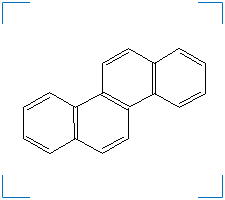Data Collection
Chrysene
CAS Number: 218-01-9
Basic Information
 Synonym(s): 1,2,5,6-Dibenzonaphthalene; 1,2-Benzophenanthracene; 1,2-Benzophenanthrene; Benzo[a]phenanthrene
Synonym(s): 1,2,5,6-Dibenzonaphthalene; 1,2-Benzophenanthracene; 1,2-Benzophenanthrene; Benzo[a]phenanthrene
Formula: C18H12
Molecular Weight: 228.293
Boiling Point (°C): 448
Melting Point (°C): 255.8
Contaminant Type: Chrysene is a polyclyclic aromatic hydrocarbon.
Notes: RED BLUE FLUORESCENT RHOMBIC PLATES FROM BENZENE, ACETIC ACID; ORTHORHOMBIC BIPYRAMIDAL PLATES FROM BENZENE; COLORLESS PLATELETS WITH BLUE FLUORESCENCE
Solubility (in water)
- Solubility:
0.0015
mg/kg
ao
Temperature (°C): 29
- Solubility:
0.002
mg/kg
ao
Temperature (°C): 25
- Solubility:
0.0018
mg/kg
ao
Temperature (°C): 25
- Solubility:
1.80E-07
g/100ml
d
- Solubility:
1.50E+00
µg/l
ak
Temperature (°C): 15
- Solubility:
6.00E+00
µg/l
ak
Temperature (°C): 25
- Solubility:
1-50
µg/l
ak
Formulation: in seawater
- Solubility:
17
µg/l
ak
Temperature (°C): 24
Formulation: practical grade
Half-Life (in soil unless otherwise noted)
- t1/2:
16
months
ak
Temperature (°C): 20
Environment: abiotic degradation in sandy loam in the dark at 700 mg/kg
- t1/2:
5; 10; infinite
days
ak
Environment: degradation in a soil system at initial conc between 4 and 500 mg/kg soil
- t1/2:
1.02 - 2.72
years
f
Environment: Based upon aerobic soil die-away test data
- t1/2:
7
years
ak
Temperature (°C): 20
Environment: biodegradation in sandy loam in the dark at 700 mg/kg
Toxicity Effects
- Organism Type:
Crustaceans
ak
Common Name: Daphnia
Scientific Name: Daphnia magna
Toxicity: 1.9 mg/l
Test: 2h LC50
Soil Organic Carbon/Water Partition Coefficients
Octanol-Water Partition Coefficients
Work Cited
|
d
|
ChemFinder. Cambridge MA: CambridgeSoft Corporation. Retrieved November, 2003 from http://chemfinder.cambridgesoft.com
|
|
f
|
Howard, P. H., R. S. Boethling, W. F. Jarvis, W. M. Meylan, and E. M. Michalenko. 1991. Handbook of Environmental Degradation Rates. Lewis Publishers., Chelsea, MI.
|
|
ak
|
Verschueren, K. 2001. Handbook of Environmental Data on Organic Chemicals, 4th edition. John Wiley & Sons, Inc., New York.
|
|
ao
|
Santodonato, J., P. Howard, D. Basu, S.D. Lee, Si Duk, and L. Grant. 1981. Health and ecological assessment of polynuclear aromatic hydrocarbons. Pages 1-364 in Journal of environmental pathology and toxicology, volume 5(1). Park Forest South, Ill. : Pathotox Publishers.
|
|
ay
|
Nagpal, N. K. 1993. Ambient Water Quality Criteria For Polycyclic Aromatic Hydrocarbons (PAHs). Pages retrieved April 2005 from http://www.env.gov.bc.ca/wat/wq/BCguidelines/pahs/index.html. British Columbia Ministry of Environment.
|